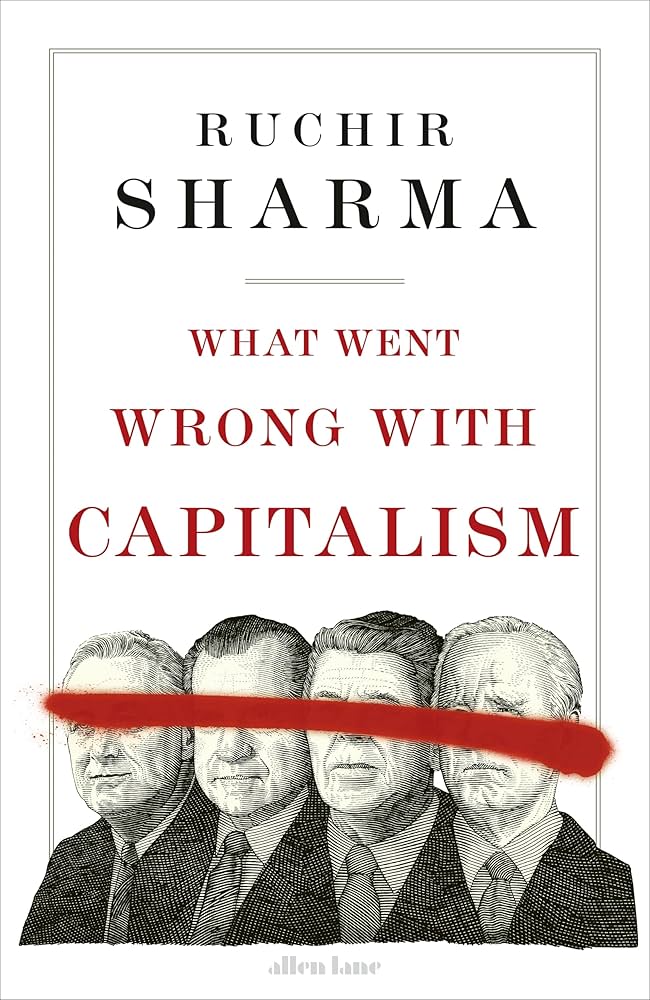
We have witnessed thirty years of neo-liberal triumphalism. Essential services have been privatised, and utilities have been sold off, while the state has seldom been so weak, and, as a result, work has become more precarious, inequality has widened to unacceptable levels, and a super-elite of mega-rich plutocrats has been allowed to grow wealthier and wealthier at everyone else’s expense. The liberal-left has so successfully established this prevailing narrative about what is wrong with modern capitalism, and how only a stronger state can fix it, that even many of its natural opponents buy into much of its analysis. Ruchir Sharma’s analysis, however, is here to make a simple point. They are completely wrong. Modern capitalism is indeed in bad shape, he argues. But not because the state is too small, but because it is too big.
What Went Wrong With Capitalism tells a powerful story about how the system of making and selling stuff has changed dramatically over the last fifty years. In Sharma’s view, the conventional wisdom is that the state grew slightly in the immediate post-war period, but its size was dramatically rolled back during the Reagan and Thatcher era, and ever since then has shrunk in size and influence. ‘Millennials, the next ruling generation, have embraced a narrative that is clear on the problems of capitalism and way too certain of the causes,’ he writes. ‘Like the media establishment, many Americans seem to assume that the story of shrinking government is true [and] if these distortions arose in a period of shrinking government, they figure, then bigger government must be the answer. But if the era of shrinking government never happened, that is exactly the wrong answer.’
Sharma brilliantly sets out the stark facts and figures on the ever expanding role of government in the modern economy. While Reagan and Thatcher were preaching the virtues of liberal, small government, low-taxes and free markets, central bankers were moving steadily in the other direction. The rot started with the former Federal Reserve chairman Alan Greenspan, ironically a devotee of the extreme liberal Ayn Rand, who started propping up the financial markets with cheaper money every time they fell a little. Ever since then, central bankers saw it as their job to tame and manage the business cycle. First interest rates were cut too close to zero, and then they started printing money on an extravagant scale, and that allowed governments to borrow to finance deficits on a scale that used to be impossible. As Sharma points out, in America potential Presidents used to pay at least lip service to balancing the books, and Bill Clinton actually managed it in one year, the last occupant of the White House to do so. Now they no longer even bother to mention it, so that by 2024, with a deficit of 6pc of GDP in a strong economy, until recently an unthinkable sum outside of wartime, the candidates compete with one another on how much more they can borrow and spend.
But it is not just debt of course. The state has been intervening more and more directly in the economy as well. In the US, Sharma points out the Code of Federal Regulations was first updated annually in the early 1960s, and has grown more than eight-fold since then, and now runs to 180,000 pages covering 240 volumes. America turned into ‘a nation of lawyers’ he argues, not because its people are naturally litigious, as is sometimes lazily assumed, but because it was the only way to cope with the often bewildering accumulation of extra rules that businesses have to follow. In Europe, it is even worse. Sharma brilliantly nails the myth of a ‘neo-liberal’ European Union, pointing out that all it has done is replace cumbersome national regulations with even more cumbersome versions designed in Brussels. ‘In part because the European Union lacks the power to tax and spend directly, its energies have been directed instead into what scholar Giandomenico Majone called “an almost pure regulatory state”, which by the late nineties was issuing regulations at an almost exponential pace.’ On both sides of the Atlantic, the story is the same, with governments attempting to micro-manage almost every aspect of commercial life. Both the Covid pandemic and now the drive to hit Net Zero targets have massively accelerated that.
The strength of the book is in its forensic use of facts to puncture left-liberal myths, and to chart the increasing role of government in our lives. For example, the number of lawyers in the US was growing by only 30,000 per decade prior to 1970, but increased to 100,000 every ten years after the tide of federal regulation grew and grew. Likewise, the number of lobbyists in Washington has overtaken the number of federal employees, with companies spending vast sums trying to manipulate the law in their favour. Almost every page contains a fresh nugget of data, each one illustrating how much more powerful the state has become. Add it all up, and Sharma paints a devastatingly accurate portrait of how massively the state has grown in size and power over the last thirty years, and more importantly, how that has slowed down the innovation and growth that were vital to a stable, free and prosperous society.
If it has a flaw, it is that the book is weaker on remedies. Sharma identifies Switzerland, Taiwan and, perhaps controversially, Vietnam as the three examples of states that have managed to get it right. They are good choices. The trouble is, voters in all the major democracies keep voting for leaders who promise to intervene more, spend more, and regulate more: Argentina is the only country in recent times to vote for less government. The hard part is to convince the voters that the state should get out of their lives, and while Sharma will convince his readers of the case, he has little to say about how to turn that into a message with mass appeal. Even so, it is an excellent book, timely and well-argued, and essential reading for anyone who wants a refreshing corrective to the prevailing wisdom.
‘What Went Wrong With Capitalism’ by Ruchir Sharma was published in 2024 by Penguin (ISBN: 978-0-24-159576-3). 384pp.
 Matthew Lynn is an author, journalist and entrepreneur. He writes for The Daily Telegraph, The Spectator and Money Week, is the author of the Death Force thrillers, and is the founder of Lume Books.
Matthew Lynn is an author, journalist and entrepreneur. He writes for The Daily Telegraph, The Spectator and Money Week, is the author of the Death Force thrillers, and is the founder of Lume Books.